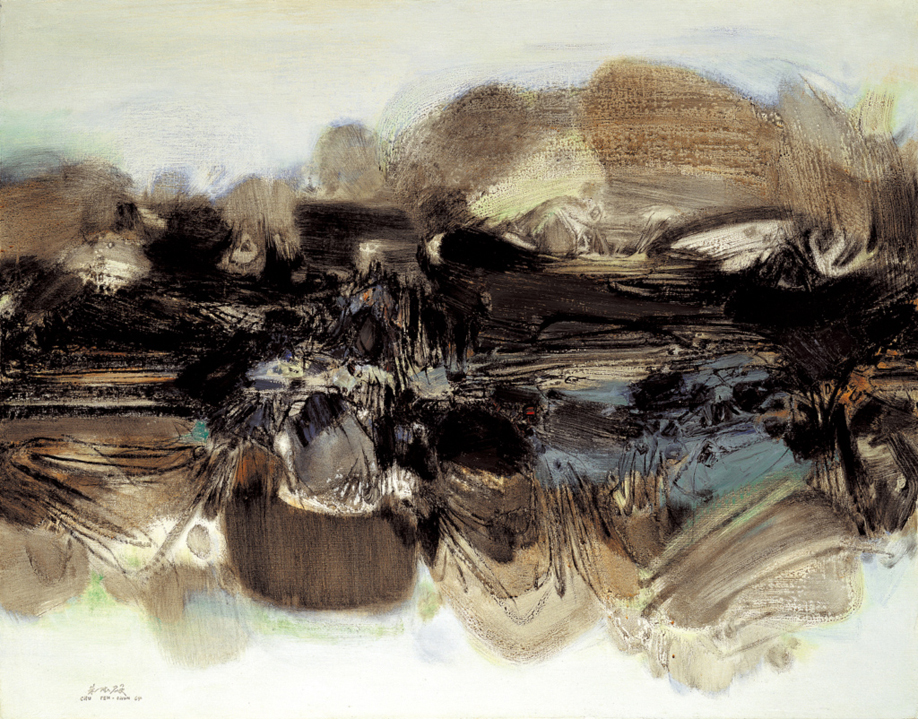|
Composition No. 190
|
|
1964 Oil on canvas 114 x 147 cm Signed lower left CHU TEH-CHUN in Chinese and English, dated 64 |
|
Estimate
9,000,000 - 15,000,000 2,195,000 - 3,659,000 281,300 - 468,800
|
|
Sold Price
12,390,000 2,861,432 369,410
|
|
|
Chu's unique abstract style began to appear in the 1960s. After living in France for many years he had a strong desire to interact with the predecessors of modern Chinese art masters. He visited the National Palace Museum in Taipei to view the grandeur of masterpieces such as: "Traveling amid Mountains and Streams" by Fan Kuan and "Early Spring" by Kuo Hsi; both artists were famous painters during the Song Dynasty. After returning to Paris, Chu created a gigantic abstract work that initiated a dialogue with Kuo Hsi's "Early Spring". The saturation of colors and lyrical rhythm present the imagery and thoughts of a painter deeply influenced by Chinese culture. This cultural provenance can be clearly discerned in his oil paintings.
 As a painter, Chu believes that history and the experience of ancestors have to be digested, understood and accepted. All of science is based on the accumulation of past experience and knowledge, as is art. Chu blends the traditional artistic concepts and adds new elements in his paintings. Ancestral experience helps the artist to convey his ideas and to relect the era chosen during the creative artistic period.
As a painter, Chu believes that history and the experience of ancestors have to be digested, understood and accepted. All of science is based on the accumulation of past experience and knowledge, as is art. Chu blends the traditional artistic concepts and adds new elements in his paintings. Ancestral experience helps the artist to convey his ideas and to relect the era chosen during the creative artistic period.
"Abstraction is a free use of imagery; the artistic conception is more important than the format. Fan Kuan once said: 'The soul and nature should be closely linked.' Master Wassily Kandinsky, the irst creator of pure abstraction in modern painting used to say: 'Abstraction should connect with nature. It is tightly united with nature.' Paul Klee also said that: 'Art does not reproduce the visible; rather, it makes visible.' This means that art is not an imitation of nature, but rather reveals the inner meaning. " (Quoted from Chu Teh-chun, Guangdong Museum of Art, Guangzhou, 2000, p. 26)
The lyrical abstraction of Chu's paintings has received great compliments in art circles, particularly in France. He blends oriental refinement with western extensity with a powerful imaginative intensity. His abstract expression has brought him into the world of modernism. The gap between eastern and western art has now been bridged harmoniously; east inally meets west. His oil paintings are inclined towards Chinese prose and poetry, while reflecting an admiration for European culture. Chu portrays the mystical beauty and dramatic appeal of natural landscapes. In effect, the aesthetic vision of his works enable the beholder to share in the artist's vivid visual perception; the boundless sense of visibility linking Chinese and western paintings is inspirational and sublime. Art has the power to reveal the ininite by opening the doors of perception.
Fan Kuan is the mentor of Chu. His "Traveling amid Mountains and Streams" revealed the generous and cold strokes outlining the mountains and rocks. The ink-wash drawings accentuate the vigor of the landscape. In comparison with Chu's "Composition No. 190" painted in 1964, the abundant hierarchy, simple color but meaningful conceptualization displays the aesthetics of ancient Chinese paintings. There's no sense of oppression in the forceful vigorousness; however, exuberance is beauty. A paradise is seen and the harmony therein echoes its counterpart, rhyme in poetry. The lovely abstract scenery conveys the integration of traditional Chinese paintings and modern art. Chu has unveiled the boundaries that people used to have in regard to western abstraction. Viewers are inspired by the lavish display of interior space in his paintings.
Chu has explored the art style in a variety of creative experiments. During the period of Lin Feng-Mian and Hsu Pei-Hung, they brought about innovation to Chinese culture by referring to western art. Nevertheless, Chu did it in another way. He has transformed his own culture into an art form, which is the task of great art of all types; the distinctive national features and nature of the epoch are well linked. The characteristics of Chu's art underwent further development. The dignified black colors reflect a sense of reticence and control in this painting. The blue-green colors along the ink-black edge symbolize that the artist is benign and digniied. While it surmounts the space-time continuum, nationality and historical age, yet the artistic originality still remains, sublime and inspirational and it elevates the viewers to the Elysian levels of artistic perception.
